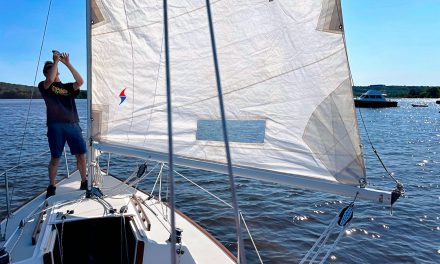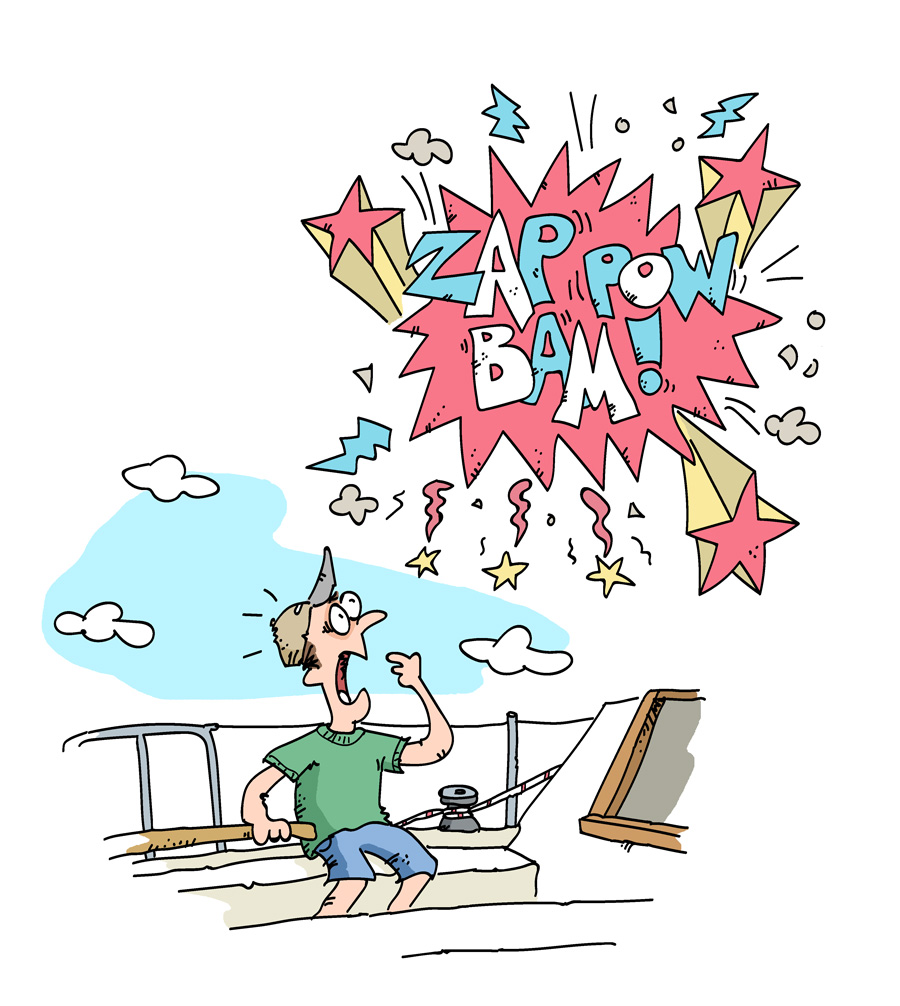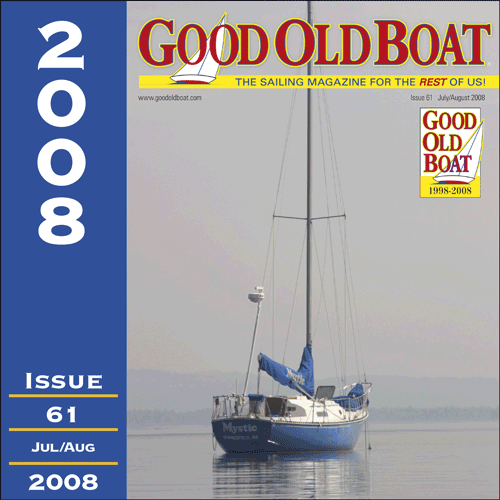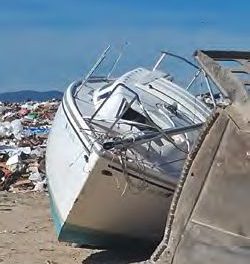A young couple finds a boat to call a home, from San Francisco Bay to the Chesapeake Bay
Issue 152: Sept/Oct 2023
The idea of buying a boat came about one afternoon in my apartment off Mission Street in San Francisco. I was working my first job and had fallen for sailing and a sailor the previous summer. Increasingly, Wednesdays and Fridays were for beer can racing and weekends were for raft-ups and longer races. My internet browser tabs were filled with sail tactics, liveaboard tips, and boat listings. I gobbled up interviews and books by those who had wandered farther offshore and wondered if we could do the same.
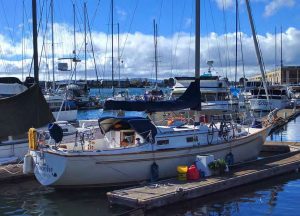
Azimuth, then named Panache, soon after purchase.
I had sketched out a budget and realized how much money we were spending on rent as we dawdled and worked up the gumption to buy a boat and live aboard. My future husband, Scott, and I were newly dating, and sinking hard-won savings into a good old boat seemed illogical at first, but also pragmatic and fun. Scott had been scouring lists of bluewater cruisers for a few years, and time together on other people’s boats helped us refine a list of desired creature comforts — a U-shaped galley, a separate standing shower, and a wraparound cockpit unseparated by winches or a wheel. Our price range necessitated a “plastic classic,” and we also preferred them stylistically. A sloop seemed sensible, although Scott dreamed of cutter rigs. For a while, we were keen on Tartan 34s and even considered trucking one to the Bay Area from Montana.
Our search slowed while Scott prepared and delivered an Express 37 back to the San Francisco Bay from Hawaii. For the two weeks or so he was out of contact, aside from a Garmin tracker link, I wondered if he would still like sailing after a few thousand miles upwind on a lightweight displacement hull. While offshore, he considered boat designs, and the name Azimuth came to him one night in the Pacific when the closest humans aside from his crew were up above on the International Space Station. An azimuth is the horizontal angle from a cardinal direction, typically north, and a celestial body. He loved the notion that with an azimuth and few other inputs, one can plot their place in the world.

Ashley and Scott spend Christmas 2017 aboard
Azimuth in Berkeley, California.
A day or two after Scott returned from Hawaii, we spotted a YachtWorld listing for a Pearson 365 sloop in nearby Emeryville. The Pearson designer, Bill Shaw, once said, “The 365 is my personal idea of what a boat should be. At that size I can put absolutely everything in the boat that I want and not get into a this or that situation.” The 365 has a V-berth for the main cabin, followed by the head to starboard, a closet, a large saloon including a pilot berth, a U-shaped galley to port, and a navigation desk to starboard. There is no quarter berth, which means the lazarettes are open for systems installs and gear storage. Most of the 365s are ketches, so the sloop cockpit felt like something from a larger vessel. The engine’s V-drive provides a few more feet for the interior, and the only trade-off is cramped access to the original Westerbeke 40 diesel engine.
The design passed our seaworthiness requirements and desired creature comforts. The photos showed a bright interior that was livable without us having to undertake any major projects, and the “as is” condition required only a new battery charger and sump pump for the shower. We had mapped out a plan to achieve boat ownership the previous summer and had made progress on pinching pennies, moving from San Francisco to more affordable Oakland, and acquiring a car to make marina living easier. Here was our next step — a boat that we couldn’t stop looking at and timing that seemed as good as any. I called the broker the next day.
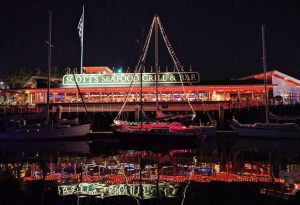
Azimuth all dressed up in lights for the Lighted Yacht Parade at Oakland’s Jack London Square.
We tried our best to keep expectations low, but we were practically buzzing when we arrived at the marina to look at the boat, named Panache. We walked the decks, stood behind the wheel, looked up at the rigging, and headed down below. This boat was larger than we had been targeting, but we figured that it would leave some room to grow. The broker could see he had us hook, line, and sinker, and still managed to help us get a good deal after the sea trial. We got a small loan and moved aboard the following week. Stars aligned to grant us a liveaboard slip in Oakland, an exit or two down the highway from the desirable Jack London Square. From there, I could bike, walk, or even kayak to work. We settled into life aboard, which included getting out of our slip most every weekend.
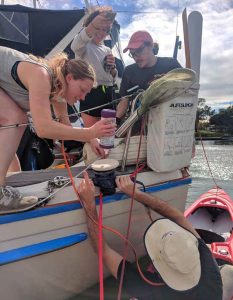
Friends make even the most mundane boat projects easier and more fun.
For the first few years, we were beyond content to be bay sailors. The 365 can technically sleep six, and we were continually piling friends aboard to explore the various anchorages of San Francisco Bay. I doubt I need to explain the appeal of getting on the water to the readers of this magazine, and perhaps the delight of sharing it with others goes without saying. We felt ridiculously lucky that our paths had crossed with each other and this vessel. Friends came over constantly to help us figure out the latest project, have a meal, or complete a seasonal craft like pumpkin carving or gingerbread boat decorating. We strung up lights for the Oakland Lighted Yacht Parade and attended monthly raft-ups with the Washed Up Yacht Club, an informal group of sailors, artists, and other DIYers. There was something so magical about that time, getting to know Azimuth alongside others who had similar means and skills to maintain and enjoy their ships of choice.
In those early days, we kept two lists: what was needed to go sailing next and what was needed to head out cruising; the former was our priority. We aimed to get out of the marina as much as possible, and our time on the water informed the upgrades we made incrementally over the years, either as things broke or we had time and money to tackle improvements.
Over time, our weekends shifted more toward offshore racing to gain the experience necessary for the nebulous cruise that inspired our boat purchase. Azimuth became more of a crash pad as we worked in office buildings and spent time at the gym to prepare for racing, and at the yacht club before and after races and practices. At the height of our racing frenzy, we enjoyed hosting crew members overnight before and after races, and took our dinghy to the yacht club to step aboard lighter, newer vessels. Sailing on various teams improved our sail-handling skills and informed our running rigging, sail purchases, and other nuances of our boat.
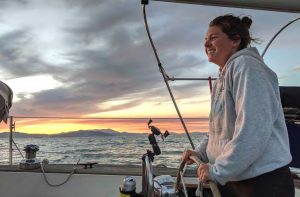
Ashley captains Azimuth and crew through a particularly serene sunset in the San Francisco
Bay in the spring of 2019.
We enjoyed the mix of racing and living aboard in San Francisco Bay and wanted to spread the fun to others, so we started an informal liveaboard race. It was open to all, but Scott required those who didn’t live aboard full time to have an unsecured potted plant along for the ride. The winner received a nice bottle of rum and second-to-last place got a bottom-shelf bottle. The debriefs on the docks in Jack London Square were always a delight, as folks figured out some new way to get their boat to go faster or discovered a new feature of the winds and currents of the bay. The race continues in the hands of friends.
When Covid-19 put a halt to racing, rafting up, and gatherings of all kinds, we found ourselves working office jobs from the confines of Azimuth. This prompted a few projects such as upgrading to an electric toilet and a larger sink to help with the endless parade of dishes. At first, we made the most of things by having a festive midday teatime and learning recipes that had long been dog-eared in our cookbooks. Eventually, the thrill of being in our favorite place together wore off and we began asking ourselves, what are we doing here?

Azimuth running down wind in the 4th annual
Liveaboard Race series.
Since buying the boat in 2016, we had consistently said we would go cruising in three years’ time. This interval required no immediate action toward the goal but kept us aligned with the dream. We were nearing our 30th birthdays and were tired of cramming our workdays, hobbies, and relationship into a small space, tied to a dock. Renting a shipping container at the nearby Bay Area Maker-farm, a junkyard turned workshop and farm, alleviated some of the pressure and gave us space for various boat and hobby projects. We felt far from family, and the bay lost some of its appeal without fun gatherings, collaborating with coworkers in person, and sailing alongside others. One day, Scott said, “What if we sail to the East Coast?”
The plan resonated right away. By sailing Azimuth to the Chesapeake Bay, we’d be closer to family, living in a place with more affordable housing and marinas, and have a transitional adventure along the way. To borrow the phrasing of a friend, we would be sailing around a continent to start a new life, just like people centuries prior.
We threw ourselves into doing the remaining projects to prepare Azimuth, a process that took almost a year of nights and weekends and a marathon haulout. On April 30, 2021, we sailed out under the Golden Gate Bridge for the last time.
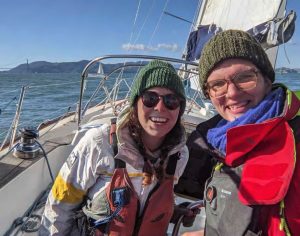
Ashley and Scott, midway through a new dodger project, catching a nice day on the Bay in the early months of 2021.
Heading down the coast in the spring was chilly and challenging as we balanced working and weather windows. We waited for the seasons to turn in San Diego and joined the Baja Ha-Ha cruising rally for some company. Our boat felt packed to the gills with supplies and spares when we first left, but gradually rose on its waterline as we gained experience. Every hundred miles or so, we bested notorious features including Point Conception, Cabo Corrientes, the Gulf of Tehuantepec, Papagayo winds, and Punta Mala. Each felt difficult but doable as we broke down every challenge into smaller next steps.
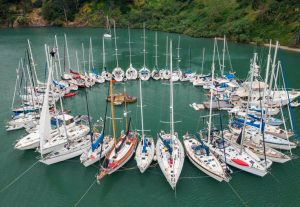
Azimuth rafted up with 40 other boats as part of the Washed Up Yacht Club’s annual Summer Sailstice event.
By the time we arrived at the Panama Canal, Azimuth had transitioned to a performance cruiser, oscillating between sailing and anchoring. We were moving quickly because of our budget and desire to get to the other side, a point that confounded many we met along the way. But there were highlights, too — the time spent offshore, the victories of fixing problems in remote places, and the simplicity of our priorities. We were granted many incredible experiences because we had the courage to leave our dock in Alameda and every dock after that. We observed nature at the pace of 5 knots (or less!) in that soothing silence of being under sail.
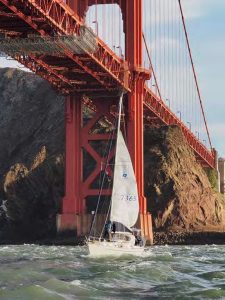
Scott raises Azimuth’s mainsail as they’re swept under the Golden Gate Bridge on a 5-knot ebb.
On the Caribbean side of Panama, we were given the chance to exchange our maintenance skills learned from the boat for room and board at an off-grid nature retreat, enabling an extra year on our planned one-year voyage. This extra time meant we could hone our language skills, explore Bocas del Toro and the San Blas Islands, and head over to the urban center of Cartagena, Colombia, to get some eastward progress while waiting for the trade winds to die down for safe passage north. We crossed the Caribbean to Isla Mujeres, Mexico, in March 2023, a 980-mile passage that was mostly uneventful aside from an extra tack or two to avoid a northerly cold front.
We crossed back into the United States in Florida in April and sailed offshore up to Charleston, South Carolina, where we were trapped for a few weeks of unseasonal northerly weather. Once in Southport, North Carolina, we dipped into the Intracoastal Waterway for the final 365 miles of the trip. We enjoyed the many free docks in North Carolina and chose the scenic Great Dismal Swamp route to round out this transitional cruise. Relying on our old motor was a test, but we made it to our new marina in Virginia without incident on June 15.
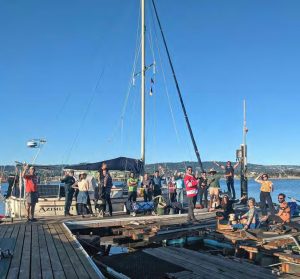
Ashley and Scott’s going away party at the docks of Encinal Yacht Club preceding the start of their journey to the Chesapeake.
After almost seven years of living aboard Azimuth, the hull has dropped on its waterline with the addition of solar, extra anchors, a life raft, a desalinator, storm sails, a dinghy, and an outboard. The bulkheads have been filled with tiny trinkets and other artwork. We move about our vessel with a fluidity that feels akin to playing an instrument. Azimuth feels like a member of the family and a connection to our past.
Now that we have stepped off the boat to live in a city again, I have a greater appreciation of how efficiently we lived within our boat’s design and the connection to nature it provided simply by floating on the waterways we sailed. Azimuth taught me what we needed and what we didn’t, and because of that boat, I live frugally and question the accumulation of stuff that seems so prevalent. Our time on board was significantly less expensive than a Bay Area apartment, and yet it unlocked the riches of the ocean and time together.
Azimuth is rising on its waterline as we move our possessions offboard and head into a new chapter as weekend sailors, exploring the many coves and creeks on our new coast. We are unfurling from the pace and priorities of this voyage and enjoying new possibilities and the solidity of land. It seems this boat will continue to grow with us.
Ashley Gremel is a writer, maker, and problem-solver. She recently completed a sail from San Francisco to the Chesapeake Bay via the Panama Canal with her husband, Scott Racette, and their salty cat, Cypress. Ashley writes weekly at cloudsformoverland. substack.com.
Thank you to Sailrite Enterprises, Inc., for providing free access to back issues of Good Old Boat through intellectual property rights. Sailrite.com


